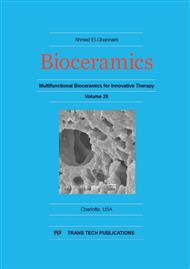p.3
p.7
p.12
p.17
p.21
p.25
p.31
p.37
Characterization of Structural and Chemical Properties of Silver Containing Hydroxyapatite Synthesized by Solid Phase Reaction
Abstract:
In this study, we investigated the physical and chemical state changes of silver in silver-containing hydroxyapatite (AgHA) composites sintered at various heat treatment temperatures. AgHA composites were synthesized by a solid phase reaction at various temperatures using composite powder prepared by ball-milling commercial highly crystalline hydroxyapatite powder and commercial silver oxide powder. Structural characterization of AgHA was performed by scanning electron microscopy (SEM), X-ray diffraction (XRD), Fourier transform infrared spectroscopy (FT-IR), and X-ray absorption near edge structure (XANES). The XRD measurement showed that peaks of metallic silver or other silver compounds disappeared at 800°C and reappeared at 1000°C. The a-axis of HA obtained by Rietveld analysis expanded drastically at 800°C. Furthermore, the SEM images showed that silver particles disappeared at 800°C and reappeared at 1000°C, as indicated by the XRD patterns. The XANES spectrum of Ag-L3 edge of AgHA sintered at 800°C was different compared to those of other references. These results suggested that calcium ions were substituted by silver ions in AgHA sintered at 800°C, according to the a-axis expansion of HA lattice caused by the substitution of hydroxyl ions by carbonate ions through the heat treatment, based on the FT-IR measurement. In addition, antibacterial tests showed that AgHA containing various chemical states of silver had good antibacterial activities in proportion to released amounts of silver.
Info:
Periodical:
Pages:
3-6
Citation:
Online since:
November 2016
Authors:
Keywords:
Price:
Сopyright:
© 2017 Trans Tech Publications Ltd. All Rights Reserved
Share:
Citation:


